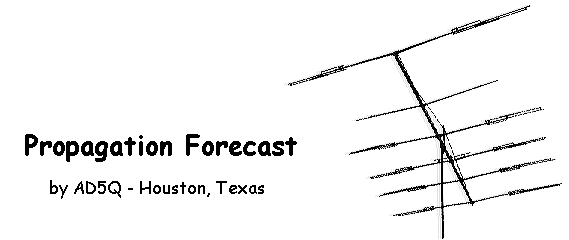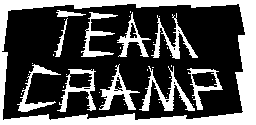
11 Years of Monthly Propagation
Reports

This monthly series
of articles began in February 1988 and ran for exactly 11 years. It therefore
chronicles DX conditions for one complete sunspot cycle. The emphasis of
the series has been on the seasonal variations in DX openings at prevailing
solar flux levels, and not on forecasting short term variations in solar
statistics. We try to help you work the DX, especially over the more difficult
paths. There is little in this series of articles that would be considered
dated material. The forecasts can be used again in the next solar cycle,
and the one after that. Simply select one from the past series based on
the time of year and currently level of solar activity.
If you want, you
can have the complete set of articles in a Zip file (free). Each
article shows the solar flux range for the month reported.
Click Here to Download the Archive (Zip format)
You might want to
take a look at current and recent solar conditions in graphic form. A glance
at this chart will aid you in selecting the right forecast so you can factor
in the seasonal effects on the bands and identify the important daily DX
openings from my articles.
The forecasts
on this page are written from the perspective of the author, and I live
in Texas (North America). Most other propagation guru's also live in the
US, but are primarily focused on events on the sun anyway. Since I focus
on actual DX openings from my location, I often receive requests from those
trying to interpret these forecasts for other locations and continents
which I have never been to. The series reflects my own operating habits
and actual experience, and the strengths and weaknesses of my own station.
I would like to encourage others to pick up where I have left off. You
could fill in where I was short on experience (SSB, WARC Bands, Low Bands),
or knowledge (physics), or report on DX conditions from other continents.
I would especially be interested in DX experience from other latitudes
- closer to the pole, equitorial regions, or the southern hemisphere. I
think a lot of DXers would find such a series interesting. It's up to YOU...
Now, here are the
articles...
January Forecasts
January
1989 -- Flux Range 186 - 302
January
1990 -- Flux Range 166 - 259
January
1991 -- Flux Range 176 - 370
January
1992 -- Flux Range 152 - 302
January
1993 -- Flux Range 104 - 141
January
1994 -- Flux Range 90 - 148
January
1995 -- Flux Range 73 - 97
January
1996 -- Flux Range 69 - 86
January
1997 -- Flux Range 67 - 78
January
1998 -- Flux Range 74 - 108
January
1999 -- Flux Range 94 - 239
February Forecasts
February
1988 -- Flux Range 98 - 115
February
1989 -- Flux Range 167 - 277
February
1990 -- Flux Range 139 - 236
February
1991 -- Flux Range 174 - 320
February
1992 -- Flux Range 196 - 288
February
1993 -- Flux Range 116 - 188
February
1994 -- Flux Range 93 - 108
February
1995 -- Flux Range 81 - 95
February
1996 -- Flux Range 68 - 76
February
1997 -- Flux Range 69 - 81
February
1998 -- Flux Range 81 - 107
March Forecasts
March
1988 -- Flux Range 101 - 132
March
1989 -- Flux Range 156 - 267
March
1990 -- Flux Range 144 - 247
March
1991 -- Flux Range 194 - 277
March
1992 -- Flux Range 155 - 200
March
1993 -- Flux Range 115 - 167
March
1994 -- Flux Range 85 - 101
March
1995 -- Flux Range 76 - 95
March
1996 -- Flux Range 67 - 74
March
1997 -- Flux Range 69 - 77
March
1998 -- Flux Range 88 - 142
April Forecasts
April
1988 -- Flux Range 100 - 147
April
1989 -- Flux Range 174 - 209
April
1990 -- Flux Range 135 - 255
April
1991 -- Flux Range 136 - 268
April
1992 -- Flux Range 128 - 206
April
1993 -- Flux Range 88 - 143
April
1994 -- Flux Range 73 - 87
April
1995 -- Flux Range 67 - 92
April
1996 -- Flux Range 67 - 74
April
1997 -- Flux Range 68 - 81
April
1998 -- Flux Range 86 - 141
May Forecasts
May
1988 -- Flux Range 101 - 149
May
1989 -- Flux Range 169 - 208
May
1990 -- Flux Range 122 - 274
May
1991 -- Flux Range 148 - 249
May
1992 -- Flux Range 99 - 145
May
1993 -- Flux Range 91 - 140
May
1994 -- Flux Range 69 - 95
May
1995 -- Flux Range 66 - 95
May
1996 -- Flux Range 66 - 78
May
1997 -- Flux Range 70 - 85
May
1998 -- Flux Range 87 - 136
June Forecasts
June
1988 -- Flux Range 108 - 183
June
1989 -- Flux Range 186 - 324
June
1990 -- Flux Range 135 - 219
June
1991 -- Flux Range 161 - 251
June
1992 -- Flux Range 99 - 130
June
1993 -- Flux Range 82 - 139
June
1994 -- Flux Range 68 - 88
June
1995 -- Flux Range 70 - 86
June
1996 -- Flux Range 67 - 74
June
1997 -- Flux Range 68 - 78
June
1998 -- Flux Range 96 - 125
July Forecasts
July
1988 -- Flux Range 133 - 192
July
1989 -- Flux Range 165 - 197
July
1990 -- Flux Range 140 - 259
July
1991 -- Flux Range 159 - 251
July
1992 -- Flux Range 96 - 176
July
1993 -- Flux Range 83 - 111
July
1994 -- Flux Range 74 - 88
July
1995 -- Flux Range 68 - 81
July
1996 -- Flux Range 65 - 87
July
1997 -- Flux Range 67 - 82
July
1998 -- Flux Range 99 - 130
August Forecasts
August
1988 -- Flux Range 112 - 191
August
1989 -- Flux Range 156 - 275
August
1990 -- Flux Range 167 - 322
August
1991 -- Flux Range 139 - 290
August
1992 -- Flux Range 93 - 156
August
1993 -- Flux Range 88 - 108
August
1994 -- Flux Range 71 - 89
August
1995 -- Flux Range 70 - 82
August
1996 -- Flux Range 67 - 81
August
1997 -- Flux Range 70 - 97
August
1998 -- Flux Range 108 - 179
September Forecasts
September
1988 -- Flux Range 116 - 188
September
1989 -- Flux Range 156 - 307
September
1990 -- Flux Range 150 - 212
September
1991 -- Flux Range 164 - 201
September
1992 -- Flux Range 100 - 139
September
1993 -- Flux Range 78 - 121
September
1994 -- Flux Range 70 - 97
September
1995 -- Flux Range 68 - 76
September
1996 -- Flux Range 66 - 74
September
1997 -- Flux Range 85 - 119
September
1998 -- Flux Range 115 - 177
October Forecasts
October
1988 -- Flux Range 149 - 200
October
1989 -- Flux Range 174 - 239
October
1990 -- Flux Range 144 - 233
October
1991 -- Flux Range 154 - 273
October
1992 -- Flux Range 98 - 175
October
1993 -- Flux Range 87 - 127
October
1994 -- Flux Range 74 - 98
October
1995 -- Flux Range 70 - 92
October
1996 -- Flux Range 66 - 73
October
1997 -- Flux Range 78 - 91
October
1998 -- Flux Range 102 - 137
November Forecasts
November
1988 -- Flux Range 139 - 190
November
1989 -- Flux Range 211 - 276
November
1990 -- Flux Range 141 - 222
November
1991 -- Flux Range 131 - 230
November
1992 -- Flux Range 125 - 176
November
1993 -- Flux Range 89 - 104
November
1994 -- Flux Range 76 - 92
November
1995 -- Flux Range 71 - 78
November
1996 -- Flux Range 68 - 106
November
1997 -- Flux Range 86 - 121
November
1998 -- Flux Range 115 - 168
December Forecasts
December
1988 -- Flux Range 147 - 255
December
1989 -- Flux Range 167 - 284
December
1990 -- Flux Range 178 - 241
December
1991 -- Flux Range 171 - 272
December
1992 -- Flux Range 116 - 173
December
1993 -- Flux Range 84 - 143
December
1994 -- Flux Range 76 - 100
December
1995 -- Flux Range 69 - 76
December
1996 -- Flux Range 66 - 88
December
1997 -- Flux Range 78 - 117
December
1998 -- Flux Range 128 - 187
ad5q@arrl.net



Cool DX Links

Ionospheric Propagation...
- IPS Radio & Space Service
- Solar images at SDAC
- Mt. Wilson 150-Foot Solar Tower

Bulletins and Information...
- KA9FOX Web Site for Contesters and DXers
- Contest Score Reports - 3830
- AC6V Index of everything for Amateur Radio
- Contesting On-Line Home Page
- K3FN DX QSL Service
- The International Morse Preservation Society

Radio Clubs...
- DFW Contest Group
- Central Texas DX and Contest Club
- Texas DX Society
- The DX Notebook (Lone Star DXA)
- Potomac Valley Radio Club
- Yankee Clipper Contest Club
- Northwest (Houston) Amateur Radio Society

Software...
- DX4WIN Logging Software For Windows
- WinTest Contest Software
- RUFZ - the CW Speed Benchmark
- Azimuthal Equidistant (Great Circle) Projection Map Server

Alternative Perspectives - None of it Mainstream...
- My link collection

- Dmitri D. Shostakovich (This is my hero)
- Tori Amos
- Laibach / Neue Slowenische Kunst
- Alternative Tentacles: Praise the Lard
- The Official Home Page of Grateful Dead
- Philip Glass on the Web
- No Borders Here: Jane Siberry
 � � � �
� � � �











